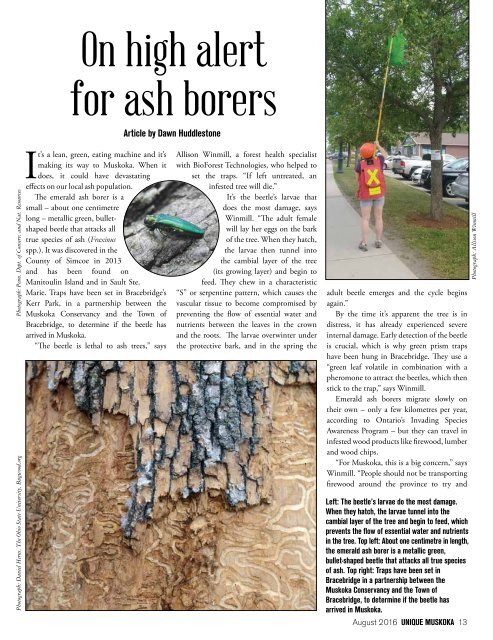Unique Muskoka August
You also want an ePaper? Increase the reach of your titles
YUMPU automatically turns print PDFs into web optimized ePapers that Google loves.
On high alert<br />
for ash borers<br />
Article by Dawn Huddlestone<br />
Photograph: Daniel Herns, The Ohio State University, Bugwood.org Photograph: Penn. Dept. of Conserv. and Nat. Resources<br />
It’s a lean, green, eating machine and it’s<br />
making its way to <strong>Muskoka</strong>. When it<br />
does, it could have devastating<br />
effects on our local ash population.<br />
The emerald ash borer is a<br />
small – about one centimetre<br />
long – metallic green, bulletshaped<br />
beetle that attacks all<br />
true species of ash (Fraxinus<br />
spp.). It was discovered in the<br />
County of Simcoe in 2013<br />
and has been found on<br />
Manitoulin Island and in Sault Ste.<br />
Marie. Traps have been set in Bracebridge’s<br />
Kerr Park, in a partnership between the<br />
<strong>Muskoka</strong> Conservancy and the Town of<br />
Bracebridge, to determine if the beetle has<br />
arrived in <strong>Muskoka</strong>.<br />
“The beetle is lethal to ash trees,” says<br />
Allison Winmill, a forest health specialist<br />
with BioForest Technologies, who helped to<br />
set the traps. “If left untreated, an<br />
infested tree will die.”<br />
It’s the beetle’s larvae that<br />
does the most damage, says<br />
Winmill. “The adult female<br />
will lay her eggs on the bark<br />
of the tree. When they hatch,<br />
the larvae then tunnel into<br />
the cambial layer of the tree<br />
(its growing layer) and begin to<br />
feed. They chew in a characteristic<br />
“S” or serpentine pattern, which causes the<br />
vascular tissue to become compromised by<br />
preventing the flow of essential water and<br />
nutrients between the leaves in the crown<br />
and the roots. The larvae overwinter under<br />
the protective bark, and in the spring the<br />
adult beetle emerges and the cycle begins<br />
again.”<br />
By the time it’s apparent the tree is in<br />
distress, it has already experienced severe<br />
internal damage. Early detection of the beetle<br />
is crucial, which is why green prism traps<br />
have been hung in Bracebridge. They use a<br />
“green leaf volatile in combination with a<br />
pheromone to attract the beetles, which then<br />
stick to the trap,” says Winmill.<br />
Emerald ash borers migrate slowly on<br />
their own – only a few kilometres per year,<br />
according to Ontario’s Invading Species<br />
Awareness Program – but they can travel in<br />
infested wood products like firewood, lumber<br />
and wood chips.<br />
“For <strong>Muskoka</strong>, this is a big concern,” says<br />
Winmill. “People should not be transporting<br />
firewood around the province to try and<br />
Left: The beetle’s larvae do the most damage.<br />
When they hatch, the larvae tunnel into the<br />
cambial layer of the tree and begin to feed, which<br />
prevents the flow of essential water and nutrients<br />
in the tree. Top left: About one centimetre in length,<br />
the emerald ash borer is a metallic green,<br />
bullet-shaped beetle that attacks all true species<br />
of ash. Top right: Traps have been set in<br />
Bracebridge in a partnership between the<br />
<strong>Muskoka</strong> Conservancy and the Town of<br />
Bracebridge, to determine if the beetle has<br />
arrived in <strong>Muskoka</strong>.<br />
<strong>August</strong> 2016 UNIQUE MUSKOKA 13<br />
Photograph: Allison Winmill



